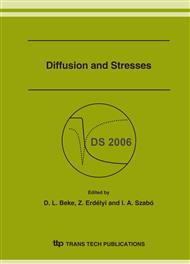p.117
p.123
p.133
p.141
p.151
p.155
p.159
p.163
p.171
Influence of Annealing Environment and Film Thickness on the Phase Formation in the Ti/Si(100) and (Ti +Si)/Si(100) Thin Film Systems
Abstract:
Influence of an annealing environment and film thickness on the phase formation in the Ti(30 nm)/Si(100), [(Ti+Si) 200 nm]/Si(100) thin film systems produced by magnetron sputtering and the Ti(200 nm)/Si(100) thin film system produced by electron-beam sputtering were investigated by X-ray and electron diffraction, Auger electron spectroscopy (AES), secondary ion mass-spectrometry (SIMS) and resistivity measurements. Solid-state reactions in the thin film systems under investigation were caused by diffusion processes during annealing in the different gas environments: under vacuum of 10-4 - 10-7 Pa, flow of nitrogen and hydrogen. It is shown that the decrease of Ti layer thickness from 200 to 30 nm in the Ti/Si(100) film system causes the increase of the transition temperature of the metastable C49 TiSi2 phase to the stable C54 TiSi2 phase up to 1070 K at vacuum annealing. During annealing in the nitrogen flow of the Ti(30 nm)/Si(100) thin film system the C49 TiSi2 is the first crystal phase which is formed at 870 K. For annealings of the [(Ti+Si) 200 nm]/Si(100) thin film system by impulse heating method or for furnace annealings in inert gas atmosphere of N2, Ar, H or higher vacuum (10-5 Pa) the crystallization process has two stages: the first metastable C49 TiSi2 phase is formed at 870 K and then at higher temperatures it is transformed to the stable C54 TiSi2 phase.
Info:
Periodical:
Pages:
159-162
Citation:
Online since:
April 2007
Keywords:
Price:
Сopyright:
© 2007 Trans Tech Publications Ltd. All Rights Reserved
Share:
Citation:


